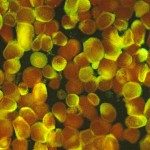Lien vers Pubmed [PMID] – 14610077
J. Biol. Chem. 2004 Jan;279(4):2430-7
We have previously demonstrated that viral particles with the properties of nonenveloped hepatitis C virus (HCV) nucleocapsids occur in the serum of HCV-infected individuals (1). We show here that nucleocapsids purified directly from serum or isolated from HCV virions have FcgammaR-like activity and bind “nonimmune” IgG via its Fcgamma domain. HCV core proteins produced in Escherichia coli and in the baculovirus expression system also bound “nonimmune” IgG and their Fcgamma fragments. Folded conformation was required for IgG binding because the FcgammaR-like site of the core protein was inactive in denaturing conditions. Studies with synthetic core peptides showed that the region spanning amino acids 3-75 was essential for formation of the IgG-binding site. The interaction between the HCV core and human IgG is more efficient in acidic (pH 6.0) than in neutral conditions. The core protein-binding site on the IgG molecule differs from those for C1q, FcgammaRII (CD32), and FcgammaRIII (CD16) but overlaps with that for soluble protein A from Staphylococcus aureus (SpA), which is located in the CH2-CH3 interface of IgG. These characteristics of the core-IgG interaction are very similar to those of the neonatal FcRn. Surface plasmon resonance studies suggested that the binding of an anti-core antibody to HCV core protein might be “bipolar” through its paratope to the corresponding epitope and by its Fcgamma region to the FcgammaR-like motif on this protein. These features of HCV nucleocapsids and HCV core protein may confer an advantage for HCV in terms of survival by interfering with host defense mechanisms mediated by the Fcgamma part of IgG.

